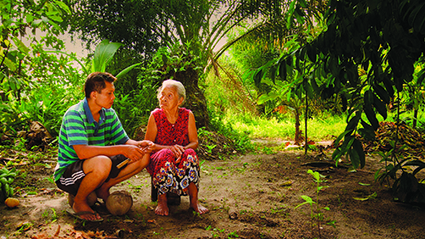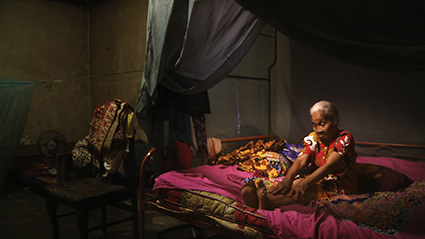Killer contrite in a heartbeat
Dan Edwards: Joshua Oppenheimer, The Look Of Silence

The Look of Silence
Documentaries often tell us something new—revealing this or that fact—but it is much rarer to find a film that makes us question, in provocative and productive ways, human nature itself. Joshua Oppenheimer has managed to do this twice over with a pair of films about the 1965 massacre of communists in Indonesia—The Act of Killing (2012) and his new work The Look of Silence (2015). And the questions he raises are intensely disquieting.
The Act of Killing (RT117, p 12) traced Oppenheimer’s interactions with various aging Indonesian gangsters who participated in the murder of around a million “communists”—a category that included intellectuals, unionists and ethnic Chinese, as well as actual party members—in a paroxysm of violence that ushered in General Suharto’s “New Order” in the mid-1960s. The gangsters proudly re-enacted their part in the slaughter for Oppenheimer in a bizarre series of scenes comprising Hollywood gangster flick clichés and kitsch musical interludes. The Look of Silence is stylistically restrained in comparison, but is perhaps even more unsettling in what it reveals about our relationship to the past.
The new film centres on Adi, an optometrist born several years after the upheavals of the mid-1960s, but bound to those events by a brother who was murdered by local militia. We see him early in the film watching a 1967 NBC news report about the massacre, in which an official explains that the communists in his village, realising “they were wrong,” had actually asked the village council to kill them. Even as the carnage was still sporadically playing across the archipelago, it seems, a self-justifying narrative was being forged by the killers.
Similarly, we see Adi throughout the film watching Oppenheimer’s contemporary footage of perpetrators proudly declaring their murderous actions half a century earlier. These images feed back into The Look of Silence, as Adi visits the killers from his local area to test their eyes, opening up chats about 1965 as he fits them with new glasses. It is an unsubtle metaphor that feels a little too perfect, even if contemporary Indonesia no doubt looks very different through the lens of those on the receiving end of the mid-60s violence.
As in The Act of Killing, most of the perpetrators initially brag about their deeds when Adi asks what they were doing in 1965, explaining that the nation—and, some add, the Americans—approved of their actions. One readily admits his obvious wealth was a direct reward for his butchery. As with the earlier film, we are left pondering what psychological scars lurk behind these enthusiastic declarations. One village head, for example, is a mess of facial tics as he tells Adi that he was only able to forestall a descent into insanity during the killing by drinking human blood. His disturbed demeanour and ongoing position of power reminds us of the extent to which ‘sanity’ is determined by social and political context.
In each of Adi’s encounters with the killers, he elicits boasts and blithe “explanations,” before calmly revealing that one of the local victims was his brother. It is in the responses to this admission that the film delves into some truly dark places. Several interviewees simply reply with threats. “Do the victims’ families want the killings to happen again?” asks one, now the speaker of the local legislature. “No? Then change! If you keep making an issue of the past it will definitely happen again.”
Much more disturbing, however, is the way most perpetrators shift in a heartbeat from celebratory descriptions of their leading roles in the massacre to denials of any involvement. The daughter of one killer even ends up hugging Adi and telling him, “Think of us as family,” after he reveals his brother’s fate. “None of his children knew,” she says of her father’s actions. “We were very young…He’s old and senile. He doesn’t remember much.” Moments earlier her father had lucidly described dumping a woman’s severed head in a rubbish bin and drinking human blood, while his daughter had commented, “I was proud my dad exterminated communists.”

The Look of Silence
Marxist philosopher Slavoj Žižek wrote that The Act of Killing was about “the ethical deadlock of global capitalism” (New Statesman, 12 July 2013), and it is true that the key ideological aim of Suharto’s New Order was Indonesia’s integration into the global capitalist economy, a move that had long been resisted by the two biggest losers in Suharto’s takeover—Indonesia’s first president Sukarno and the Indonesian Communist Party. But Žižek’s reading lazily assumes that the economic system is primarily to blame, and as such misses the more provocative implications of Oppenheimer’s work.
The events Oppenheimer delves into—like the Khmer Rouge’s genocide in Cambodia, Mao’s Cultural Revolution, Stalin’s Great Purge and the Nazis’ Holocaust—incontrovertibly demonstrate that humankind’s capacity for cruelty is limitless, whatever our political proclivities. The fewer restraints there are on power, the more power will flirt with mass annihilation. More shockingly, Oppenheimer shows us that human subjectivity is endlessly malleable, and that with very few exceptions, people adapt to the conditions in which they live. Many can and will participate in mass murder if society tells them that slaughter is necessary. And they can and will deny all responsibility—or even involvement—when circumstances change. The Look of Silence demonstrates this many times over.
So what does this mean for possible ways of moving forward in Indonesia, and for the process of “truth and reconciliation,” such as played out in South Africa in the post-Apartheid era? Confessions of atrocity and expressions of remorse perhaps provide a degree of closure for victims and their families. But when we are so easily able to slide between torturing, raping and killing and expressing regret when circumstances demand, do public displays of contrition mean anything? Would those who enforced Apartheid have been so publicly regretful if the political winds had not shifted? Or would they have been glibly celebrating their violence in the manner of Oppenheimer’s onscreen subjects? There is certainly scant historical evidence to suggest displays of remorse forestall further abuses, as South Africa’s example attests. The Look of Silence is so unsettling precisely because it makes us face these questions and destabilises easy assumptions about the positive effects of airing repressed historical trauma.
The one certain lesson contained in both The Act of Killing and The Look of Silence is that without the restraint of law, power of any political stripe inevitably drifts towards slaughter. Power will always be able to justify itself, but once the line of arbitrary violence is crossed and endorsed, no amount of contrition will bring back the dead. Just ask Reza Berati.
–
The Look of Silence; director Joshua Oppenheimer, producer Signe Byrge Sørensen; Denmark, Indonesia, Norway, Finland, UK, 2015; Melbourne International Film Festival, 30 July–16 Aug
RealTime issue #128 Aug-Sept 2015 pg. 28






